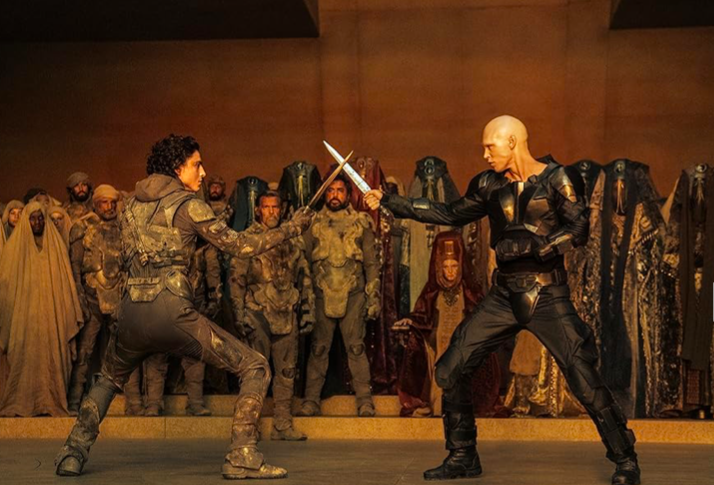Thump, Thump, Thump. The rhythmic beats of a thumper draws Shai-Hulad through the spice-covered hills of Arrakis towards an exiled duke burdened by prophecy, his hooks ready to sink into the coarse skin of the sandworm… and the hearts of “Dune” fanatics.
Paul Atreides returns to the big screen right where he left off after the end of the first film, a fatherless and houseless boy with a thirst for revenge against those who conspired against his family. “Dune: Part Two” surpasses the worldbuilding of “Dune” with stunning cinematography, intense character relationships and a dream cast, allowing the film to join sci-fi movie royalty.
While the first movie did not lack any visual appeal, especially when showing the cloudy ambiance of the Atreides’ ancestral home of Caladan, part two completely transports viewers into the burning heart of Arrakis and Giedi Prime, the terrifying home of the Harkonnens. Now acclimating to his life amongst the Freman, Paul is able to see the sand dunes as more than just a waterless hellscape and grows to find kinship and joy in the planet while recognizing the power it provides. The cinematography translates this new mindset, presenting the glimmering spice gliding across the sand, the calming orange rays of the Arrakis sunset and the emphasis on the graceful movements of the Freman. While outsiders see Arrakis natives as savage “rats,” audience members are shown their humanity through Paul’s experiences, while their oppressors are shown in an even darker light than before.
The emphasis on the distinct cultures of the different houses makes the scale of this movie feel massive. The Harkonnens, known for their cruelty, are characterized through their eerie hairless appearance, severe architecture and monochrome aesthetic, giving viewers a subtle but effective glimpse into the background of characters like Feyd-Rautha and Vladimir Harkonnen. The settings and costuming create visual and political parallels between each house that exemplifies the worldbuilding established in its film predecessor. If you’re not interested in the deeper meaning behind the aesthetics, Princess Irulan’s stunning headpieces and the flowy Bene Gesserit garb are enough reason to sit in the theater for three hours.
Fans were saddened to see that Zendaya’s Chani was only in the first “Dune” for a measly seven minutes, but “Dune: Part Two” allows the actress to shine. Her portrayal of the skeptical Freman creates a fantastic contrast with the religious fanatics and followers of Paul or “Muad’Dib,” while adding more dimension that her book counterpart— who easily accepts the Atreides rule — lacked. Zendaya was fearsome but also brought a welcome sensitivity and uncertainty to such a grounded character.
While the returning cast was impeccable, and Timothee Chalamet saying “may thy knife chip and shatter” is comparable to a spine-tingling ASMR, Arrakis’ newcomers utterly stole the spotlight. Princess Irulan didn’t have much screen time, but Florence Pugh’s steady voice and sharp glances allowed her to be a subtle but powerful presence amongst industry titans. And perhaps one of the best additions to the film, Austin Butler’s performance as Feyd-Rautha had a grotesque playfulness that contrasted wonderfully with Chalamet’s steely portrayal of Paul. Feyd’s aggressive fighting style, snakelike movements and gravelly voice — reminiscent of Stellan Skarsgård’s Baron — made him one of the most intimidating antagonists on the silver screen in a long time.
This film screams blockbuster just through its action sequences. While many movies use violence as a lazy way to fill runtime, each adrenaline inducing scene in “Dune: Part Two” is integral to the plot, highlighting each characters’ unique fighting styles while making the three-hour run time feel miniscule. As Paul garnered more believers, his “heroic” acts could have easily been a lengthy mishmash of unnecessary killing, but watching him and the Freman erupt from the sand to utterly terrorize spice production was mesmerizing and showed audiences the true scale of the “sand power” that could lead Paul to victory.
It isn’t a cinematic masterpiece without composer extraordinaire Hans Zimmer making the score. Just like the story itself, the atmospheric music transcends time with an almost archaic sound with a tempo that progresses with the film’s themes. These timeless sounds can be attributed to the unique instruments Zimmer’s team created and the use of electronic instruments. The driving force of this film is Chani and Paul’s love story, providing a warmth and passion that conflicts with both their agendas, and Zimmer crafts their relationship’s theme, “A Time of Quiet Between the Storms,” with tender care. It swells with the hopefulness of young love, allowing the audiences to forget the strife the characters face.
“Dune: Part Two” is director Denis Villeneuve’s love letter to this beloved book series. He is able to take the source material and passionately reimagine it in a way that creates a new generation of “Dune” fans. Sci-fi is a daunting genre to tackle with complex worldbuilding and confusing terminology, but this film invites skeptics with open arms and will have viewers leaving the theatre saying “as it was written.”







